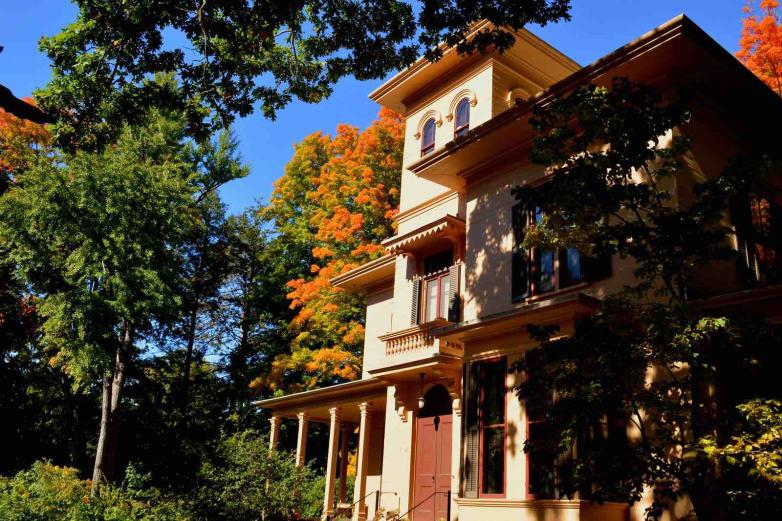Emily Dickinson Museum Announces Reopening of The Evergreens After Years of Preservation Work

Evergreens exterior
Closed since 2019, the Emily Dickinson Museum has now completed a multi-year preservation effort at The Evergreens, aimed at improving environmental conditions for objects in its recently documented collection, and reducing energy consumption.
Reopening on March 1, The Evergreens is an integral component of the American literary site interpreting and celebrating Emily Dickinson’s life and legacy. Located just west of the Homestead, The Evergreens was built for the poet’s brother Austin and his family in 1856. The lives of the Dickinson families at the Homestead and The Evergreens were closely linked, both in their daily conduct and in the private lives that unfolded in the houses. These connections had a profound impact on Emily Dickinson’s poetry and, later, on the posthumous publication of her verse and the preservation of her legacy.
Supported by grants from the National Endowment for the Humanities and the Massachusetts Cultural Facilities Fund, the project focused first on reducing energy consumption through building envelope repairs, new insulation, and light filtration. It continued with installation of a museum-grade HVAC system to maintain temperature and relative humidity in ranges that promote the preservation of sensitive collections objects.
The museum's Executive Director Jane Wald said: “We are so pleased that this important project has reached a successful conclusion. The Evergreens is an extraordinary house, unusually preserved, and steeped in the histories of the Dickinson family and the town of Amherst. That it has been little changed since the end of the 19th century and remains full of Dickinson family possessions was a distinct choice by family members and heirs, but one that led to decades of environmental conditions unfriendly to collections. Improvements to the building envelope and an effective heating and cooling system are a significant contribution to the preservation of the Dickinson home, history, and material legacy.”
The Evergreens is thought to have been designed by prolific Northampton architect William Fenno Pratt — the house is one of the earliest unchanged examples of Italianate domestic architecture in Amherst. Under Susan Dickinson’s direction, The Evergreens quickly became a center of the town’s social and cultural life, with notable visitors such as Ralph Waldo Emerson, Wendell Philips, Harriet Beecher Stowe, and Frederick Law Olmsted.
Austin and Susan Dickinson lived at The Evergreens until their respective deaths in 1895 and 1913. Their only surviving child, Martha Dickinson Bianchi, edited numerous collections of her aunt’s poetry and authored biographical works about her in the 1920s and 1930s. She continued to live in the house, and preserved it without change, until her own death in 1943. Her heirs – co-editor Alfred Leete Hampson, and later his widow, Mary Landis Hampson – recognized the tremendous historical and literary significance of a site left completely intact and sought ways to ensure the preservation of The Evergreens as a cultural resource. The house is still completely furnished with Dickinson family furniture, household accouterments, and decor selected and displayed by the family during the nineteenth century.
“Reintroducing The Evergreens to our interpretive program has been a long-awaited step,” says the museum's Senior Director of Programs Brooke Steinhauser. “The condition of the house is uniquely evocative of the lives lived there. We can share more fully with visitors the stories not just of the poet’s daily inspiration stemming from these family relationships, but also the remarkable way her poetry came to the world posthumously and the motivations of the extraordinary people who recognized her genius and dedicated their lives to sharing it.”















